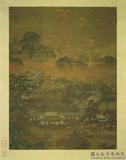明王紱松亭高士圖 軸
推薦分享
資源連結
連結到原始資料 (您即將開啟新視窗離開本站)後設資料
- 資料識別:
- 故畫000386N000000000
- 資料類型:
- 類型:繪畫
- 型式:靜態圖像
- 著作者:
- 王紱
- 主題與關鍵字:
- 寒林.枯樹 房舍 松 篷舟 漁船 橋 亭 寺廟 瀑布 樵夫 高士(士人、隱士) 侍從(侍女、童僕) 江河、湖海
- 出版者:
- 數位化執行單位:國立故宮博物院
- 格式:
- 本幅 254.2x53.6公分、全幅 80.2公分
- 關聯:
- 石渠寶笈初編﹝御書房﹞,下冊,頁1141&*故宮書畫錄﹝卷五﹞,第三冊,頁283&*故宮書畫圖錄,第六冊,頁51-52&*王紱也有人寫作王黻,字孟端,號友石,又號九龍山人。江蘇無錫人。生於至正二十二年(西元一三六二),死於明永樂十四年(西元一四一六)。孟端人品高潔,詩文書畫都很好。畫山水師法王蒙、倪瓚。 此幅畫群峰秀立於雲表,樓宇結構於山腰,懸泉飛漱,下臨成溪。近岸松陰,傍水搭橋,茅亭小築中,二高士展卷相對。畫山石濕筆皴染兼施。筆墨似異於本院收藏其它王紱作品。 &*Wang Fu was a native of Wu-hsi in Kiangsu. His style name was Meng-tuan and his sobriquets Yu-shih, Chiu-lung shan-jen, and Ch'ing-ch’eng shan-jen. His personal name, Fu, also had another reading. He was a man of wide learning, and a skilled poet, calligrapher, and painter. He held the office of Court Attendant, and was well known in his own time for his ink paintings of bamboo. He followed the Yüan dynasty masters in his landscape paintings, approaching particularly closely the antique and refined harmony of Wang Meng and Ni Tsan. This painting shows serried peaks rising above the clouds, in their midst stands a storied temple. Cataracts fly murmuring through the air, below joining a stream. Shady pines rise close to the bank and a bridge spans the stream. In the midst of this scenery a pavilion has been built. Two scholars face each other, scrolls spread out between them. Different from other Wang Fu's works in our museum collection, a wet brush has been used to paint the wrinkles and the colours of the mountains and rocks.
- 管理權:
- 國立故宮博物院
授權聯絡窗口
- 國立故宮博物院圖像授權、出版授權、影音資料授權-申請流程說明
http://www.npm.gov.tw/zh-TW/Article.aspx?sNo=03003061






